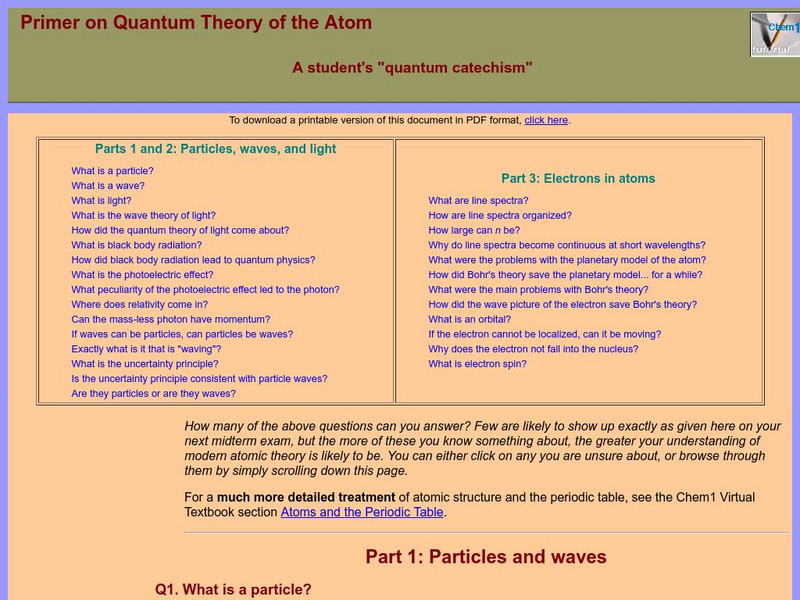Curated OER
Can We Measure the Impossible?
In this measurement worksheet, students explore methods to measure the thickness of foil. They write an essay on how they calculated the thickness of the foil, and the number of atoms thick it is. Students create labeled sketches to...
Curated OER
Structure of the Atom
Young scholars practice drawing the atomic structure of several different elements. They complete critical thinking questions about atomic structure and compare the atomic mass units for different ions and isotopes of an element.
Curated OER
Atoms, Kinetic Theory, Solids and Fluids
Students identify and describe the building blocks that make up an atom. They also compare the ages of atoms to the ages of the materials they compose,as well as, give examples that illustrate the small size of atoms.
Curated OER
Hazardous Waste
Students define technology and relate the definition to the production of electricity using nuclear energy. They also list the technologies involved and relate the use of these technologies to their effect on society in general, and...
Curated OER
Sleuth Rays
Students conduct a close examination of the atom's electrons, and discover how to theorize the energy levels, observe the brightness of light, classify colors, and measure temperature.
Curated OER
Science: Not just Gold
Learners articulate a possible relationship between arsenic and gold deposits in a written statement using data to substantiate the relationship they describe. They use real data to determine the source of the arsenic in the drinking...
Curated OER
Splitting the Atom
High schoolers use the Internet to research the history of the splitting of the atom. They use that research to prepare a presentation on an aspect of that topic. A map is generated to record findings and results.
Curated OER
Fuels for Everything -- Splitting Atoms
Learners participate in a lab activity in which they simulate the process of nuclear fission. They make predictions and write down their observations during the activity. They share their results with the class.
Curated OER
Climate & Atmosphere: A Global & Local Perspective
Middle schoolers complete a series of activities in which they study atoms, molecules, and the presence of atmosphere. They study the water cycle and the Greenhouse Effect by investigating and completing handouts.
Curated OER
Matter And Its Changes
Fifth graders explore the phases of matter, make observations of matter, the physical and chemical properties of matter, solutions and mixtures, formation of molecules and atoms and molecules all through hands on activities.
Concord Consortium
The Molecular Workbench Database: Models of the Atom's Electron Orbitals
Learn about atomic structure and the multiple theories of atomic structure in this simulation.
Georgia Department of Education
Ga Virtual Learning: Physical Science: Matter and the Atom
Students investigate the structure and parts of the atom, and learn about atomic mass and atomic number. They also explore the differences among solids, liquids, gases, and plasma.
PBS
Pbs Learning Media: Periodic Table of the Elements Essay
This essay, written for Teachers' Domain, describes the foresight and pattern recognition that Russian chemist Dmitri Mendeleyev used to develop the modern periodic table of elements.
University of Colorado
University of Colorado: Ph Et Interactive Simulations: Quantum Wave Interference
When do photons, electrons, and atoms behave like particles and when do they behave like waves? In this interactive, use quantum detectors to explore how measurements change the waves and the patterns they produce on the screen.
University of Colorado
University of Colorado: Ph Et Interactive Simulations: Atomic Interactions
Explore the interactions between various combinations of two atoms. Turn on the force arrows to see either the total force acting on the atoms or the individual attractive and repulsive forces. Try the "Adjustable Attraction" atom to see...
University of Colorado
University of Colorado: Ph Et Interactive Simulations: States of Matter: Basics
After watching this simulation, students will be able to describe characteristics of the three states of matter. They will watch as atoms and molecules change between solid, liquid and gas phases.
Science Museum, London
Science Museum: Online Stuff: Atomic Firsts
Read about three famous British atomic physicists, each of whom won a Nobel Prize. J.J. Thompson discovered the electron, Ernest Rutherford successfully split an atom, and George Paget Thomson proved that electrons had wave-like properties.
Simon Fraser University
Chem1 Virtual Textbook: The Basics on Atomic Theory
As part of the Virtual Textbook, this site examines all things related to Atomic Theory including information on atoms, molecules, formulas, equations, nomenclature, and more.
Simon Fraser University
Chem1 Virtual Textbook: Primer on Quantum Theory of the Atom
Covering a range of topics related to the quantum theory of the atom, this site provides a three-part dissection of atomic theory including information on particles, waves, light, electrons, and atoms.
Ohio State University
Betha Chemistry Tutorial
This site resource offers tutorials on the gas laws, balancing chemical equations, and quantum mechanics.
University of Colorado
University of Colorado: Ph Et Interactive Simulations: University of Colorado: Build and Atom
Build an atom out of protons, neutrons, and electrons, and see how the element, charge, and mass change. Then play a game to test how the ideas work!
University of Colorado
University of Colorado: Ph Et Interactive Simulations: Atomic Interactions
Explore the interactions between various combinations of two atoms. Observe the the total force acting on the atoms or the individual attractive and repulsive forces. Customize the attraction to see how changing the atomic diameter and...
University of Colorado
University of Colorado: Ph Et Interactive Simulations: Stern Gerlach Experiment
An interactive simulation that teaches about quantum mechanics, spin, and quantum measurement through a classic Stern-Gerlach Experiment. By observing the spin of atoms as an intrinsic angular momentum, students learn to measure to reach...
American Association for the Advancement of Science
Aaas: Project 2061: Topic: Atoms, Molecules, and States of Matter
[Free Registration/Login Required] Create a science test that checks for student understanding in science, for common misconceptions, as well as for correct ideas. This is a list of key ideas related to Atoms, Molecules, and States of...
























